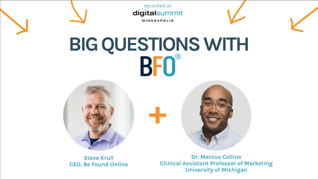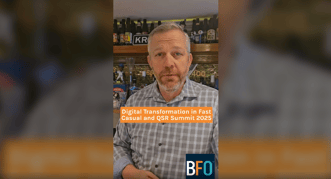Surrounded & Starved: The Marketing Data Desert and Planning Your Escape Route
April 15, 2024
9 Minute Read
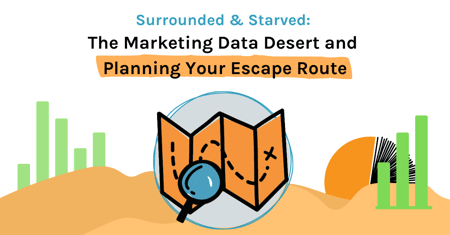
Repeat after me: Data is an asset to your business.
The more accurate it is, the more detailed it is, the better. But too often, we are inundated with data that isn’t usable to our marketing efforts. It's like being stuck in the middle of the desert. You know there is water somewhere - either underground, in the middle of a cactus, or lying stagnant in a ditch with some funky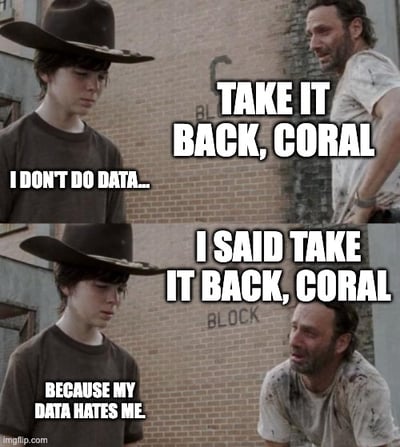 green stuff growing in it - but turning it into a solution for dehydration can seem impossible. So what are you to do?
green stuff growing in it - but turning it into a solution for dehydration can seem impossible. So what are you to do?
In case that intro wasn’t leading enough, that's the purpose of this blog. Today, I am going to focus on the marketing data desert that many of us find ourselves in and how to create an escape route that leads to an oasis with functional data that actually informs your objectives and goals. Speaking of goals, I have two for this blog:
- I want to inspire you, as a business owner or decision maker, to get excited about your data strategy, and
- I want you to start thinking about a plan for storing historical data in a way that is usable.
Why Is Marketing Data a Valuable Asset to My Business?
There is a lot to cover today, so I am going to keep this short and sweet and let the bullet points do the talking. If you’re already convinced your marketing data is a valuable asset to your business, feel free to skip to the next section. If you don’t, here’s where I convince you.
convinced your marketing data is a valuable asset to your business, feel free to skip to the next section. If you don’t, here’s where I convince you.
- Informed Decision Making: Data provides insights into various aspects of the business, such as customer behavior, market trends, and operational efficiency. Analyzing this data helps businesses make informed decisions rather than relying on guesswork or intuition.
- Understanding Customers: Data allows businesses to understand their customers better. By analyzing customer demographics, preferences, and buying patterns, businesses can tailor their products, services, and marketing strategies to meet customer needs effectively.
- Competitive Advantage: In today's competitive market, having access to and effectively utilizing data can provide a significant competitive advantage. Businesses that can harness data to improve their operations, innovate their products, or enhance their customer experience are better positioned to outperform their competitors.
- Predictive Analytics: With advanced analytics techniques, businesses can predict future trends and outcomes based on historical data. This capability allows businesses to anticipate market shifts, identify potential opportunities or risks, and proactively adjust their strategies accordingly.
- Efficiency and Cost Reduction: Data-driven insights can help businesses optimize their processes, streamline operations, and reduce costs. By identifying inefficiencies or areas for improvement through data analysis, businesses can allocate resources more effectively and minimize wastage.
- Personalization: Data enables businesses to personalize their interactions with customers. Whether through targeted marketing campaigns, personalized product recommendations, or tailored customer service experiences, businesses can use data to create more meaningful and engaging interactions with their audience.
- Risk Management: Data analysis can help businesses identify and mitigate various risks, such as financial risks, supply chain disruptions, or cybersecurity threats. By monitoring relevant data metrics, businesses can proactively manage risks and safeguard their operations.
Convinced you need to be utilizing your data to make marketing decisions (and storing it for long term use)? Grab your horse with no name.
The Marketing Data Desert
During my career in Digital Marketing, I have worn a variety of hats and been actively involved in almost every facet that goes into a campaign, from analyst to director, I have had my hat in many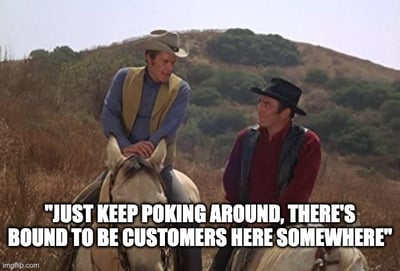 rings. As an agency, we most often work with the in-house marketing department of a brand/business to help fill the gaps in their SEO or Paid Media campaigns. I don’t have enough fingers to count the number of times I’ve started work with a Marketing Director only to have them tell me one of the big three that is an indicator they have ended up in the data desert:
rings. As an agency, we most often work with the in-house marketing department of a brand/business to help fill the gaps in their SEO or Paid Media campaigns. I don’t have enough fingers to count the number of times I’ve started work with a Marketing Director only to have them tell me one of the big three that is an indicator they have ended up in the data desert:
- They don’t trust their data.
- Their data is in too many different places and they don’t know how to bring it together to properly analyze it.
- They don’t know how to effectively use their main analytics platform (I’m looking at you Google Analytics 4).
If you can’t derive meaning from the data you have, it is as good as useless. A 2023 study by Salesforce found that 73% of business leaders agree that data helps reduce uncertainty and make more accurate decisions in business conversations. 8 in 10 business leaders also said that data is critical in their decision making process. Despite these beliefs, this study also found that
- Only 29% of business leaders are using data to inform their strategy when launching into new markets.
- 41% of business leaders cite a lack of understanding of data because its too complex or not accessible enough
- 33% of business leaders cite the lack of ability to generate insights form data
- 30% are overwhelmed by the amount of data, which is expected to more than double in size by 2026.
- Only 17% of business leaders are using data to help guide their climate targets.
Every Escape Route Needs a Good Data Strategy
Finding your data oasis starts with a solid data strategy - you need to plan your escape route from the desert. This is the top recommendation I typically have when speaking with prospects who have found themselves in a data desert. But what does a good data strategy look like?
who have found themselves in a data desert. But what does a good data strategy look like?
As with most strategy planning, you need to start with your end goal(s) and work backwards. What are you trying to accomplish with your data? For most organizations, it's going to revolve around mapping the customer journey so that you know where people are finding you, how they are interacting with you, and what pathway most often leads to a conversion. We also want to make sure we’re paying attention to who these people are and any similarities they might have so that we can build out some solid audience profiles for targeting.
Collecting this type of information should be one of the primary goals of your data strategy. The other should be ensuring that the data you collect is usable. Part of developing an effective data strategy is understanding who is going to be using the data. I recommend asking yourself who will be the primary person analyzing the data, what their data analysis skill level is, and how much time they will have to comb through data before making a decision. Bear Grylls is going to navigate a desert differently than a tourist.
Lastly, PLEASE make sure your data is accurate. If you aren’t confident configuring the tracking you need, hire a specialist (I happen to know someone). Analytics platforms often change too rapidly for someone who isn’t dedicated to data to properly configure. You will save your organization a ton of money if you do it right the first time. Inaccurate data impacts every other decision you make in your marketing campaigns. It also helps to have someone to consult with that does data strategy for a living. They will be able to provide invaluable insights surrounding macro and micro conversions that you may not have been thinking of that will more accurately track the patterned user behavior you are trying to identify.
Choosing Your Proverbial LifeStraw (Finding the Analytics Tools That Make Sense for Your Success)
If your data strategy is your map, the analytics tools are everything you pack in order to survive your journey through the desert. You need to pick a good analytics platform to act as your main point of truth for your marketing data, then properly configure it. Every social media, advertising, email, and other third party marketing platform has been programmed to slightly weigh the conversions it receives over the others. You need an analytics platform that will track interactions based on your configurations so that you are getting as close to the truth as possible.
truth for your marketing data, then properly configure it. Every social media, advertising, email, and other third party marketing platform has been programmed to slightly weigh the conversions it receives over the others. You need an analytics platform that will track interactions based on your configurations so that you are getting as close to the truth as possible.
Now disclaimer here, BFO is a Google Partner. Our Data & Analytics Team specializes in Google products and we have found success with them which is why we continue to do so. Simply put, they are an easily scalable solution for any sized business and highly customizable so that there is a configuration to meet any need. The rest of this section is going to talk about the Google based solutions we would recommend.
To cut to the point: I recommend that Google Analytics 4 act as your main point of truth.
Now, many people are upset at Google Analytics for sunsetting Universal Analytics last July and forcing everyone to start using GA4. GA4 is a completely different data model than UA which just means it tracks things a little differently. However, that also means that your prior configuration probably didn’t transfer over correctly if you got automigrated. And no one really wants to learn how to navigate the new user interface of GA4 (it does leave something to be desired). This really sucks. BUT DON’T GIVE UP ON GA4.
When properly configured, GA4 is a powerhouse and will help you to future-proof your marketing data for adjustments in collection due to new data privacy legislation. It also connects really nicely with Google Ads for enhanced audience building, you can import data from most any source into it, and there is a native BigQuery integration which can really take your reporting to the next level (more on that in a later blog).
GA4 is the LifeStraw I would use to quickly pull safe, drinkable water from the stagnant puddle of desert water that is your marketing data. However, if you are like most of the world and only transitioned to GA4 last July, you are likely about to lose all of your historical UA data on July 1, 2024 when Google deletes it. YOU NEED TO BACK IT UP! I highly recommend pulling this data into a warehouse like BigQuery to store long-term and potentially connecting it to a dashboard like the one BFO offers so that you can use it for analysis. This historical data is a massive asset to your business (as outlined above) and is instrumental in understanding seasonality and trends in behavior.
The Send-Off Speech
The field of marketing data & analytics is advancing rapidly. There is more opportunity than ever to connect insights across multiple touchpoints and craft marketing campaigns that are truly data driven. However, this is one small facet of the world of marketing, and it is hard to stay on top of the constant changes unless you are dedicating a significant amount of time to it. If you feel stuck in the data desert, I highly recommend reaching out to an expert to help you craft and configure a data strategy that is effective for your needs. BFO is here to be that helping hand if you need one.
P.S. Time is ticking on backing up any UA data you’d like to keep. Click here to learn how BFO could do it for you.
Want to stay ahead of all these crazy changes this year? Subscribe to our monthly newsletter!

Maggie Sauer
With a background in SEO, Analytics, Email Marketing, and Omni Channel Strategy, Maggie utilizes her love for data-driven strategies in her role as the Director of Strategic Partnerships.
CATEGORIES
SUBSCRIBE TO OUR BLOG
Stay up to date with the latest industry best practices in digital marketing!























.png?width=339&height=179&name=Webinar%20Banner%20(1).png)



.png?width=339&height=179&name=July%20Webinar%20(Newsletter).png)

.png?width=339&height=179&name=Webinar%20Banner-April-02%20(1).png)
%20(4).png?width=339&height=179&name=Webinar%20Banner-May-02%20(1)%20(4).png)




.png?width=339&height=179&name=March%202023%20Webinar%20Ad%20(autoresponder).png)



















































